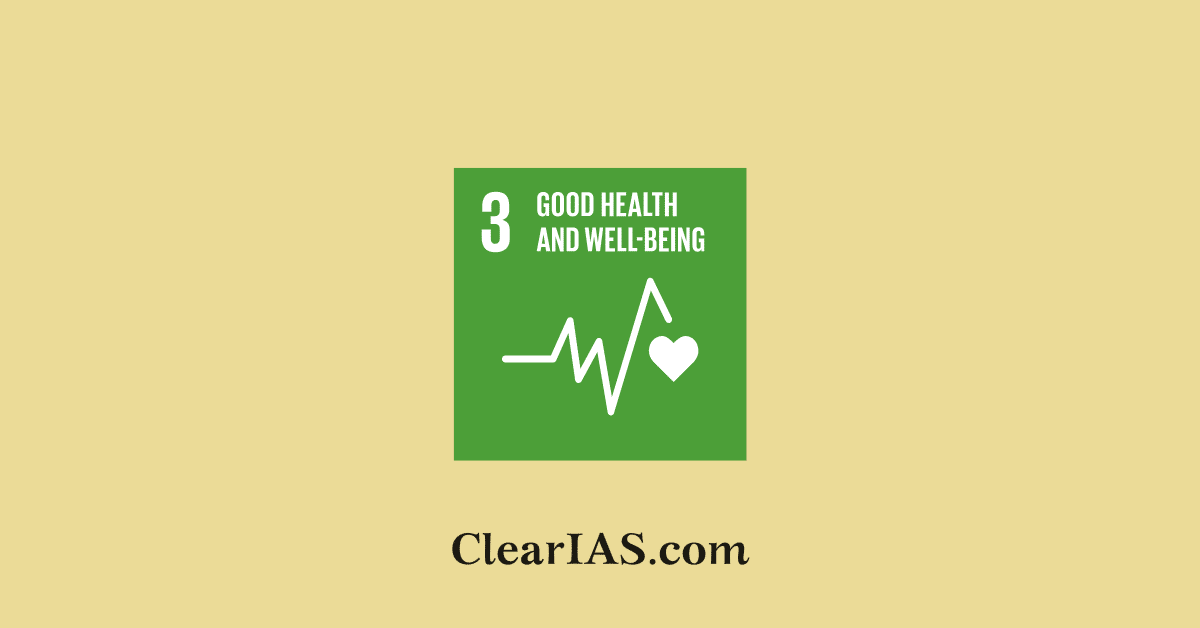
India’s Progress on SDG 3: Good Health and Well-Being has not been up to the mark, even after achieving better rank in the overall SDG index. Read here to know about the reasons for less progress in the health and well-being of the country.
India has achieved its best-ever rank in the Sustainable Development Goals (SDG) Index 2025– 99th out of 167 countries, an improvement from 109th in 2024. The rise reflects progress in infrastructure, sanitation, and basic services.
However, SDG 3: Good Health and Well-Being remain one of the most challenging areas, with persisting gaps in maternal health, child mortality, life expectancy, and equitable access to healthcare, especially in rural and tribal areas.
Status of India’s Progress on SDG 3
Indicator |
Current Status (2025) |
SDG Target |
Gap |
Maternal Mortality Ratio (MMR) |
97 deaths per 100,000 live births |
70 |
Lagging |
Under-Five Mortality Rate |
32 per 1,000 live births |
25 |
Lagging |
Life Expectancy |
70 years |
73.63 years |
Lagging |
Out-of-Pocket Expenditure on Health |
13% of total consumption |
7.83% |
Nearly double |
Immunisation Coverage |
93.23% |
100% |
Near-universal, but not achieved |
While India has made progress, with immunisation coverage reaching above 90% and MMR showing a significant decline over the past decade, the pace of improvement needs to accelerate to meet the 2030 targets.
Reasons for Gaps in Achieving SDG 3 Targets
- Access and Infrastructure Challenges
- Inadequate number of doctors, nurses, and specialists in rural and remote areas.
- Poor infrastructure in PHCs and CHCs, shortage of medicines, equipment, and staff.
- Non-Economic Determinants of Health
- Socio-Cultural Barriers
- Stigma around mental health, reproductive health, and adolescent health prevents utilisation of available services.
- Gender bias and low female autonomy affect maternal health outcomes.
- Double Burden of Disease
- Communicable diseases: Malaria, TB, and leprosy persist in pockets.
- Non-communicable diseases account for over 60% of deaths in India, putting additional pressure on the healthcare system.
- Impact of the COVID-19 Pandemic
- Disrupted immunisation drives, antenatal care, and elective surgeries.
- Resource diversion slowed progress on TB elimination and NCD screening.
Measures to Enhance India’s Progress on SDG 3
- Universal Health Insurance & Financial Protection
- Expand Ayushman Bharat, PMJAY to cover more households, reduce catastrophic health expenditure, and encourage institutional care.
- Strengthening Primary Healthcare
- Upgrade PHCs and HWCs (Health & Wellness Centres) with skilled staff, telemedicine facilities, and essential diagnostics.
- Early detection and treatment at the primary level reduce the disease burden and cost.
- School Health and Preventive Education
- Include a structured health, hygiene, and nutrition curriculum.
- Promote mental health awareness and counselling at the school level.
- Cross-Sectoral Convergence
- Integrate efforts across ministries, Health, Women & Child Development, Jal Shakti, Education, for holistic outcomes.
- Ensure safe water (Jal Jeevan Mission), sanitation (Swachh Bharat), and nutrition (Poshan Abhiyaan) work in tandem.
- Strengthening Local Governance
- Empower Panchayati Raj Institutions and Urban Local Bodies to implement health plans and conduct social audits.
- Accelerate Flagship Schemes
- Mission Indradhanush for universal immunisation.
- LaQshya aims to improve maternity care quality and reduce maternal deaths.
- National Health Mission to upgrade rural health infrastructure.
- Use of Digital Health
- National Digital Health Mission (ABDM) to provide health IDs, digital records, and telemedicine access, especially for rural and remote populations.
Way forward
Achieving SDG 3 requires a systems approach that integrates health with nutrition, sanitation, education, and livelihoods.
- India must focus on preventive and promotive healthcare, bridge the urban-rural gap in infrastructure, strengthen human resources, and invest in health financing to reduce out-of-pocket expenses.
- A community-centric approach, leveraging ASHAs, ANMs, and local governance, combined with digital innovations and cross-sectoral convergence, can help India accelerate progress and achieve SDG 3 by 2030.
Conclusion
India’s rise in the SDG Index is a positive sign, but SDG 3 remains the litmus test for inclusive development.
Health outcomes directly impact education, productivity, and poverty reduction.
Therefore, achieving SDG 3 by 2030 requires a multi-pronged approach, strengthening primary care, reducing financial barriers, integrating health with nutrition and sanitation programmes, and leveraging digital health innovations.
A people-centric, preventive health system will not only help India meet its SDG 3 targets but also ensure a healthier, more productive population, driving sustained socio-economic growth.







Leave a Reply